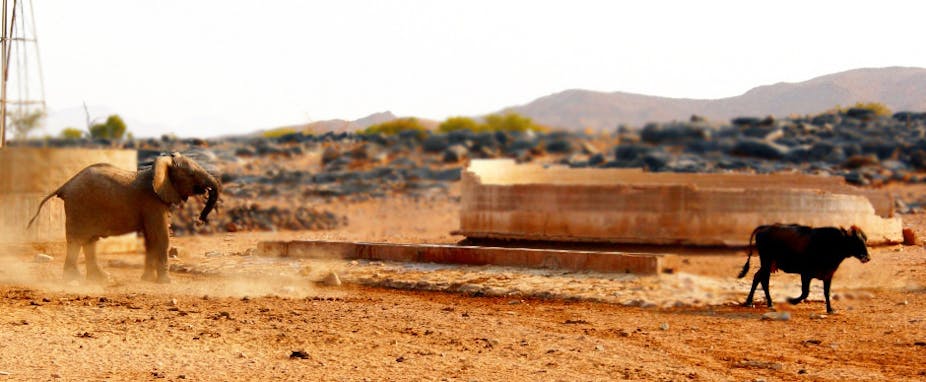A huge challenge in some of Africa’s animal-rich countries is human-wildlife conflict – when wildlife negatively affects people’s livelihoods or people negatively affect wildlife. It’s a big challenge in Kenya where most wildlife lives close to human settlements, and people have converted land to other uses that are incompatible with wildlife. As a result, claims for wildlife compensation have risen sharply over the past five years.
It’s therefore important to understand how the problem is approached, by communities, government and conservation groups. To this end, we studied cases of human-wildlife interaction in the Tsavo conservation area in southern Kenya.
Made up of three national parks, the Tsavo conservation area covers 21,000 Square kilometre, 4% of Kenya’s land mass. It has over 60 species of mammals – including lions, Kenya’s largest elephant population and buffalo. And even though less than a quarter of the conservation area’s boundary has an electric fence, it is surrounded by human settlements. Communities here engage in either pastoralism or small-scale farming.
We surveyed 347 households in the area and found that, despite many approaches to mitigate conflict between people and animals, there’s been an increase in the last ten years.
From the interviews, we drew the conclusion that this is due to the erosion of traditional approaches in resolving conflicts. And also due to the encroachment of designated wildlife protection areas on community land. This has resulted in forced evictions and restricted community access to resources, like watering holes.
Our findings suggest that a combination of traditional and modern approaches is needed in dealing with human-wildlife conflict.
Types of conflict
Two types of conflict were found to happen in our area of study.
The first was when people, and their livestock, moved into the conservation area to access resources —- like grazing land. The second was when wild animals dispersed from the conservation area onto community land, either as a part of their natural migration or to feed on crops.
The most frequently mentioned crop-raiding animals were; baboons, monkeys, elephants, buffaloes, bush pigs and warthogs. The main predators of domestic animals were lions and spotted hyena.
Another threat was that of disease transmission when the wildlife and livestock come into close contact. Buffaloes can transmit tick-borne diseases —- like East Coast fever which can kill the livestock. While wildebeest carry diseases, like the virus that causes malignant catarrh fever in cattle.
Other negative effects include the loss of grazing, water, school and farm structures (usually by elephants) and the costs accrued in trying to protect property.
Managing conflict
We found two basic approaches of managing human-wildlife conflict: prevention and mitigation.
The aim of preventive measures is to minimise the risk of conflicts and can include removing either the people or the animals, using barriers to separate the two or employing repelling tactics.
Mitigation is used after the conflict has occurred. This includes animal control where animals are either killed or captured for translocation. This is carried out by the Kenya Wildlife Service in collaboration with other conservation groups.
Traditional methods involve both preventative as well as mitigation strategies.
On the prevention front, communities would repel wild animals by making a noise by banging metal objects together, erecting scarecrows, burning chilli pepper, using fire, burning cow dung or using dogs as a deterrent.
On the mitigation front, communities would use traps, chemical repellents, fear provoking stimuli, guarding, spears or arrows to kill the animal.
But these measures aren’t working for a variety of reasons.
Many of the traditional practices are either on the wane, or they’re banned. Also, animals soon learn that some of the traditional methods don’t really pose a threat and ignore them.
As a result communities have turned to reporting incidences to wildlife conservation groups or regulatory authorities, like the Kenya Wildlife Service. This hasn’t been effective because of slow reaction time and a lack of compensation.
Finally, communities may not all agree on the best approach. For instance, when it comes to fences, while communities who farm want the protection of a fence, pastoralists want ease of movement to graze their animals during dry seasons.
Moving forward
But there are some lessons moving forward. The communities that live with the wildlife, have valuable insights into what works and what doesn’t.
They made some recommendations in terms on how conflict could be minimised. These included:
Providing adequate and timely compensation for damaged property and human injuries by the Kenya Wildlife Service
Greater vigilance by the Kenya Wildlife Services in monitoring wild animal movements so that they are better managed and, in case of conflict, response time is faster
Employing local people as community scouts and rangers in the wildlife conservation services
Providing animals with water inside and outside of the conservation area —- particularly during the dry season
Providing wildlife conservation benefits to schools affected by animals —- like covering fees for some students
Promoting positive wildlife conservation attitudes among locals through education and ensuring that affected communities enjoy tangible benefits from conserving wildlife which would increase their willingness to live with it
Managing human-wildlife conflict calls for a better understanding of the problem so that a better management plan is put in place – one that is facilitated and rolled out by government representatives, local communities and the private sector.

